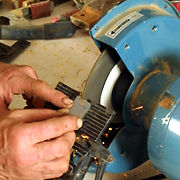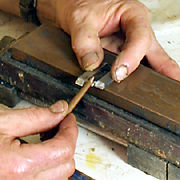A Do-It-Yourself Molding Machine
Make a custom molding cutter to match the profile of old sash or other damaged trim.
In the February/March 2004 issue of Fine Homebuilding (#161), restoration carpenter David Gibney explains his process of restoring and reglazing old double-hung windows. Here he describes a unique solution to the challenge of duplicating a sash part that’s beyond repair.
A single-bladed molding head cutter is an inexpensive, but very effective tool for making sash repairs. This tool comes with a variety of profiles, one of which is a blank cutter blade that can be used like a planer or custom-ground to replicate an odd profile.
 1. Installing the custom-made cutterhead.
1. Installing the custom-made cutterhead.  2. Tracing the profile onto a blank cutter.
2. Tracing the profile onto a blank cutter.
To transfer the profile of a damaged sash part, such as the muntin shown in the photo above left, I first have to put a 35° angle on the end of the muntin (this equals the cutting angle of the rotating blade). Then I use a can of spray paint to trace the profile onto the face of the blade (photo above right).
 3. Grinding the profile roughly to shape.
3. Grinding the profile roughly to shape.  4. Fine-tuning the profile with a small, round file.
4. Fine-tuning the profile with a small, round file.
It often takes a variety of bench grinding wheels, Dremel bits and hand files to carve out the correct profile, but so far I’ve been able to replicate any part of any window sash that I couldn’t get any other way.
David Gibney is a restoration contractor in Smithsburg, Maryland.
Photos: Tom O’Brien
Fine Homebuilding Recommended Products
Fine Homebuilding receives a commission for items purchased through links on this site, including Amazon Associates and other affiliate advertising programs.

Festool Cordless Track Saw (TSC 55 KeB-F)

Milwaukee Compact Cordless Router (2723-20)






